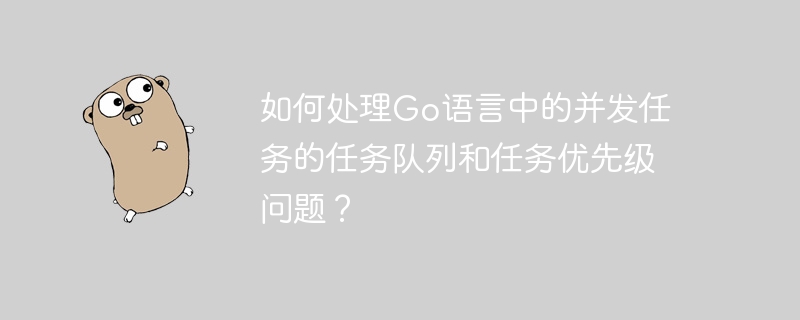Home >Backend Development >Golang >How to deal with task queue and task priority issues of concurrent tasks in Go language?
How to deal with task queue and task priority issues of concurrent tasks in Go language?
- 王林Original
- 2023-10-10 12:10:521376browse

How to deal with the task queue and task priority issues of concurrent tasks in the Go language?
In concurrent programming in Go language, task queue and task priority are two common problems. This article explains how to deal with both issues and provides specific code examples.
1. Task queue issues
Task queues are often used to process a large number of tasks and execute them one by one in order. In the Go language, channels can be used to implement task queues.
The sample code is as follows:
func worker(tasks chan func()) {
for task := range tasks {
task()
}
}
func main() {
tasks := make(chan func())
// 启动多个并发的worker
for i := 0; i < 5; i++ {
go worker(tasks)
}
// 向任务队列中添加任务
for i := 0; i < 10; i++ {
tasks <- func() {
fmt.Println("Task", i)
}
}
close(tasks) // 关闭任务队列
// 等待所有worker完成任务
wg := sync.WaitGroup{}
wg.Add(5)
for i := 0; i < 5; i++ {
go func() {
defer wg.Done()
for range tasks {
}
}()
}
wg.Wait()
}In the above example, the worker function receives tasks from the tasks channel and executes them. The main function creates a tasks channel and starts multiple worker goroutines. Then, 10 task functions were added to the tasks channel through a loop. Finally, the tasks channel is closed through the close function.
2. Task priority issue
Task priority is used to define the execution order of tasks. Task prioritization issues can be solved by using priority queues.
The sample code is as follows:
// 任务结构体
type Task struct {
Priority int // 任务优先级
Content string // 任务内容
}
// 优先级队列
type PriorityQueue []*Task
func (pq PriorityQueue) Len() int {
return len(pq)
}
func (pq PriorityQueue) Less(i, j int) bool {
return pq[i].Priority < pq[j].Priority
}
func (pq PriorityQueue) Swap(i, j int) {
pq[i], pq[j] = pq[j], pq[i]
}
func (pq *PriorityQueue) Push(task interface{}) {
*pq = append(*pq, task.(*Task))
}
func (pq *PriorityQueue) Pop() interface{} {
old := *pq
n := len(old)
task := old[n-1]
*pq = old[:n-1]
return task
}
func main() {
pq := make(PriorityQueue, 0)
// 添加任务到优先级队列
heap.Push(&pq, &Task{Priority: 3, Content: "Task 1"})
heap.Push(&pq, &Task{Priority: 1, Content: "Task 2"})
heap.Push(&pq, &Task{Priority: 2, Content: "Task 3"})
// 从优先级队列中取出任务并执行
for pq.Len() > 0 {
task := heap.Pop(&pq).(*Task)
fmt.Println("Executing", task.Content)
}
}In the above example, the Task structure defines the priority and content of the task. The PriorityQueue type implements the priority queue function by implementing the heap.Interface interface. The main function creates an empty priority queue pq and adds three tasks using the heap.Push method. Then, take the task from the priority queue through a loop and execute it.
Through the above code examples, we can learn how to handle the task queue and task priority issues of concurrent tasks in the Go language. These methods allow us to better organize and control the execution sequence of concurrent tasks and improve program performance and efficiency.
The above is the detailed content of How to deal with task queue and task priority issues of concurrent tasks in Go language?. For more information, please follow other related articles on the PHP Chinese website!

